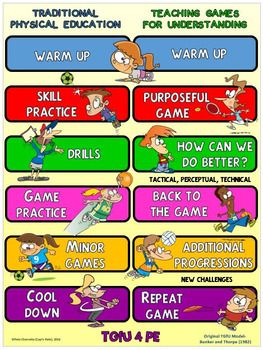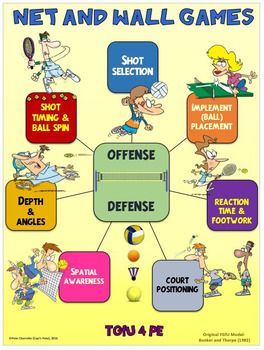Traditional method of teaching is when a teacher directs students to learn through memorization and recitation techniques thereby not developing their critical thinking problem solving and decision making skills (Sunal et al 1994) while modern or constructivist approach to teaching involves a more interacting, student-based of teaching. In particular, the relative benefits of the Teaching Games for Understanding (TGfU) approach have been compared to traditional skill-drill approaches to games teaching. However, many discussions of.
Cite this guide: Bowen, Ryan S., (2017). Understanding by Design. Vanderbilt University Center for Teaching. Retrieved [todaysdate] from https://cft.vanderbilt.edu/understanding-by-design/. |
Overview
Understanding by Design is a book written by Grant Wiggins and Jay McTighe that offers a framework for designing courses and content units called “Backward Design.” Instructors typically approach course design in a “forward design” manner, meaning they consider the learning activities (how to teach the content), develop assessments around their learning activities, then attempt to draw connections to the learning goals of the course. In contrast, the backward design approach has instructors consider the learning goals of the course first. These learning goals embody the knowledge and skills instructors want their students to have learned when they leave the course. Once the learning goals have been established, the second stage involves consideration of assessment. The backward design framework suggests that instructors should consider these overarching learning goals and how students will be assessed prior to consideration of how to teach the content. For this reason, backward design is considered a much more intentional approach to course design than traditional methods of design.
This teaching guide will explain the benefits of incorporating backward design. Then it will elaborate on the three stages that backward design encompasses. Finally, an overview of a backward design template is provided with links to blank template pages for convenience.
The Benefits of Using Backward Design
“Our lessons, units, and courses should be logically inferred from the results sought, not derived from the methods, books, and activities with which we are most comfortable. Curriculum should lay out the most effective ways of achieving specific results… in short, the best designs derive backward from the learnings sought.”
In Understanding by Design, Wiggins and McTighe argue that backward design is focused primarily on student learning and understanding. When teachers are designing lessons, units, or courses, they often focus on the activities and instruction rather than the outputs of the instruction. Therefore, it can be stated that teachers often focus more on teaching rather than learning. This perspective can lead to the misconception that learning is the activity when, in fact, learning is derived from a careful consideration of the meaning of the activity.
As previously stated, backward design is beneficial to instructors because it innately encourages intentionality during the design process. It continually encourages the instructor to establish the purpose of doing something before implementing it into the curriculum. Therefore, backward design is an effective way of providing guidance for instruction and designing lessons, units, and courses. Once the learning goals, or desired results, have been identified, instructors will have an easier time developing assessments and instruction around grounded learning outcomes.
The incorporation of backward design also lends itself to transparent and explicit instruction. If the teacher has explicitly defined the learning goals of the course, then they have a better idea of what they want the students to get out of learning activities. Furthermore, if done thoroughly, it eliminates the possibility of doing certain activities and tasks for the sake of doing them. Every task and piece of instruction has a purpose that fits in with the overarching goals and goals of the course.
As the quote below highlights, teaching is not just about engaging students in content. It is also about ensuring students have the resources necessary to understand. Student learning and understanding can be gauged more accurately through a backward design approach since it leverages what students will need to know and understand during the design process in order to progress.
“In teaching students for understanding, we must grasp the key idea that we are coaches of their ability to play the ‘game’ of performing with understanding, not tellers of our understanding to them on the sidelines.”
The Three Stages of Backward Design
“Deliberate and focused instructional design requires us as teachers and curriculum writers to make an important shift in our thinking about the nature of our job. The shift involves thinking a great deal, first, about the specific learnings sought, and the evidence of such learnings, before thinking about what we, as the teacher, will do or provide in teaching and learning activities.”
Stage One – Identify Desired Results:
In the first stage, the instructor must consider the learning goals of the lesson, unit, or course. Wiggins and McTighe provide a useful process for establishing curricular priorities. They suggest that the instructor ask themselves the following three questions as they progressively focus in on the most valuable content:

What should participants hear, read, view, explore or otherwise encounter?
This knowledge is considered knowledge worth being familiar with. Information that fits within this question is the lowest priority content information that will be mentioned in the lesson, unit, or course.
What knowledge and skills should participants master?
The knowledge and skills at this substage are considered important to know and do. The information that fits within this question could be the facts, concepts, principles, processes, strategies, and methods students should know when they leave the course.
What are big ideas and important understandings participants should retain?
The big ideas and important understandings are referred to as enduring understandings because these are the ideas that instructors want students to remember sometime after they’ve completed the course.
The figure above illustrates the three ideas. The first question listed above has instructors consider the knowledge that is worth being familiar with which is the largest circle, meaning it entails the most information. The second question above allows the instructor to focus on more important knowledge, the knowledge and skills that are important to know and do. Finally, with the third question, instructors begin to detail the enduring understandings, overarching learning goals, and big ideas that students should retain. By answering the three questions presented at this stage, instructors will be able to determine the best content for the course. Furthermore, the answers to question #3 regarding enduring understandings can be adapted to form concrete, specific learning goals for the students; thus, identifying the desired results that instructors want their students to achieve.
Stage Two – Determine Acceptable Evidence:
The second stage of backward design has instructors consider the assessments and performance tasks students will complete in order to demonstrate evidence of understanding and learning. In the previous stage, the instructor pinpointed the learning goals of the course. Therefore, they will have a clearer vision of what evidence students can provide to show they have achieved or have started to attain the goals of the course. Consider the following two questions at this stage:
- How will I know if students have achieved the desired results?
- What will I accept as evidence of student understanding and proficiency?
At this stage it is important to consider a wide range of assessment methods in order to ensure that students are being assess over the goals the instructor wants students to attain. Sometimes, the assessments do not match the learning goals, and it becomes a frustrating experience for students and instructors. Use the list below to help brainstorm assessment methods for the learning goals of the course.
- Term papers.
- Short-answer quizzes.
- Free-response questions.
- Homework assignments.
- Lab projects.
- Practice problems.
- Group projects.
- Among many others…
Stage Three – Plan Learning Experiences and Instruction:
The final stage of backward design is when instructors begin to consider how they will teach. This is when instructional strategies and learning activities should be created. With the learning goals and assessment methods established, the instructor will have a clearer vision of which strategies would work best to provide students with the resources and information necessary to attain the goals of the course. Consider the questions below:
- What enabling knowledge (facts, concepts, principles) and skills (processes, procedures, strategies) will students need in order to perform effectively and achieve desired results?
- What activities will equip students with the needed knowledge and skills?
- What will need to be taught and coached, and how should it best be taught, in light of performance goals?
- What materials and resources are best suited to accomplish these goals?
Leverage the various instructional strategies listed below:
The Backward Design Template
A link to the blank backward design template is provided here (https://jaymctighe.com/resources/), and it is referred to as UbD Template 2.0. The older version (version 1.0) can also be downloaded at that site as well as other resources relevant to Understanding by Design. The template walks individuals through the stages of backward design. However, if you are need of the template with descriptions of each section, please see the table below. There is also a link to the document containing the template with descriptions provided below and can be downloaded for free.
Backward Design Template with Descriptions (click link for template with descriptions).
References
- Sample, Mark. (2011). Teaching for Enduring Understanding. Retrieved from http://www.chronicle.com/blogs/profhacker/teaching-for-enduring-understanding/35243.
- Wiggins, Grant, and McTighe, Jay. (1998). Backward Design. In Understanding by Design (pp. 13-34). ASCD.
This teaching guide is licensed under a Creative Commons Attribution-NonCommercial 4.0 International License.
Education, as with other industries, has evolved in leaps and bounds in recent years. Traditional pedagogical techniques, based on a teacher explaining a topic and students taking notes, may still be useful on occasion, but education today revolves more around encouraging the student to awaken their curiosity and desire to learn.
A number of different teaching techniques have emerged due to this change in education. Many of these teaching techniques are not actually new! The use of technology in the classroom has simply given education a new lease of life allowing us to approach old ideas in new ways.
Traditional Model Vs Teaching Games For Understanding Kids
Outlined below are some popular teaching techniques that have arisen from the integration of technology in education.
6 Teaching Techniques You Should Know:
1. Flipped Classroom (Inverting your class):
The Flipped Classroom Model basically involves encouraging students to prepare for the lesson before class. Thus, the class becomes a dynamic environment in which students elaborate on what they have already studied. Students prepare a topic at home so that the class the next day can be devoted to answering any questions they have about the topic. This allows students to go beyond their normal boundaries and explore their natural curiosity.
GoConqr’s free online learning tools can be integrated into the Flipped Classroom teaching model. Using GoConqr, you can easily share resources with a group, in this case a class, allowing students to study these resources from home and prepare for the next class.
2. Design Thinking (Case Method):

Traditional Model Vs Teaching Games For Understanding Money
This technique is based on resolving real-life cases through group analysis, brainstorming, innovation and creative ideas. Although “Design Thinking” is a structured method, in practice it can be quite messy as some cases may have no possible solution.
However, the Case Method prepares students for the real world and arouses their curiosity, analytical skills and creativity. This technique is often used in popular MBA or Masters classes to analyze real cases experienced by companies in the past.
Ewan McIntosh, an advocate of Design Thinking, created The Design Thinking School as part of his “No Tosh” consulting group. No Tosh harnesses the creative practices of some of the best media and tech companies in the world to coach teaching methods to implement the concept. Design Thinking for Educators also provides teachers with an online toolkit with instructions to explore Design Thinking in any classroom. Click here to download the free toolkit now.
3. Self-learning:
Curiosity is the main driver of learning. As a basic principle of learning, it makes little sense to force students to memorize large reams of text that they will either begrudgingly recall or instantly forget. The key is to let students focus on exploring an area which interests them and learn about it for themselves.
Traditional Model Vs Teaching Games For Understanding People
A perfect example of a teaching technique based on self-learning is outlined by Sugata Mitra at the TED conference. In a series of experiments in New Delhi, South Africa and Italy, the educational researcher Sugata Mitra gave children self-supervised access to the web. The results obtained could revolutionize how we think about teaching. The children, who until then did not even know what the internet was, were capable of training themselves in multiple subjects with unexpected ease.
A common technique for exploring self-learning is the use of Mind Maps. Teachers can create a central node on a Mind Map and allow students the freedom to expand and develop ideas. For example, if the focus is the Human Body, some students may create Mind Maps on the organs, Bones or Diseases that affect the human body. Later the students would be evaluated according to the Mind Maps they have created and could collaborate with each other to improve each others Mind Maps and come to a more comprehensive understanding of the Human Body.
Want to implement these teaching techniques in your classroom? Sign up now to use GoConqr’s Mind Maps, Flashcards, Quizzes, Course Builder & other free online study tools here:
4. Gamification:
Learning through the use of games is one of the teaching methods that has already been explored especially in elementary and preschool education. By using games, students learn without even realizing. Therefore, learning through play or ‘Gamification‘ is a learning technique that can be very effective at any age. It is also a very useful technique to keep students motivated.
The teacher should design projects that are appropriate for their students, taking into account their age and knowledge, while making them attractive enough to provide extra motivation. One idea may be to encourage students to create quizzes online on a certain topic. Students can challenge their peers to test themselves and see who gets a higher score. In this way, students can enjoy the competition with peers while also having fun and learning.
5. Social Media:
A variant of the previous section is to utilize social media in the classroom. Students today are always connected to their social network and so will need little motivation to get them engaged with social media in the classroom. The ways you can use teaching methods are quite varied as there are hundreds of social networks and possibilities.
A good example is the initiative carried out by the Brazilian Academy of Languages “Red Ballon”, which encouraged students to review the tweets of their favorite artists and correct grammatical errors that they committed in an effort to improve their English language skills!
6. Free Online Learning Tools:

There is an array of free online learning tools available which teachers can use to encourage engagement, participation and a sense of fun into the classroom. Teachers can create an interactive and dynamic classroom environment using, for example, online quizzes to test student’s knowledge.
If you haven’t used GoConqr’s free online learning tools yet, sign up now to create Mind Maps, Flashcards, Quizzes, Course and even Flowcharts. Encourage your students to sign up to GoConqr too so that you can create a Group and invite each of your students to become a member. This means you can share study resources directly with each student online and even apply the Flipped Classroom Model to your teaching methods.
Follow the link for a GoConqr Mind Map with a summary of these 6 teaching techniques should know:
As you can see, technology has created many teaching techniques that can help you connect better with your students.
Have you had experiences with these teaching techniques? Do you have different techniques you’d like to share? Comment below to share your experiences with others!
About the GoConqr Blog
Our blog is part of GoConqr, a Free Learning Platform for Creating, Sharing & Discovering Learning Resources that help students and teachers achieve their learning objectives. Click here to start creating Mind Maps, Flashcards, Notes, Quizzes, Slides Flowcharts & Courses now!
